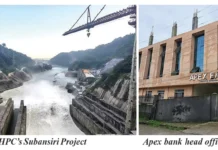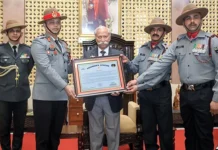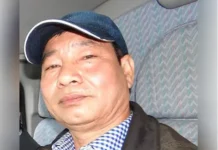[ Jayanta Roy Chowdhury ]
SELA, 3 Jan: The snow-covered epitaph put up by India’s Border Roads Organization at the top of the 13,700 feet high Sela Pass reads: “When you come to the end of the road, oh my old friend there is always a hill to be climbed just ahead.”
The black granite marker, which must have been hauled from many hundred kilometres away, was put up on 14 December, 1972, some 10 years after the 1962 war in memory of the men of the ‘Fikar (Worry) Not’ 14 Border Roads Task Force who died while constructing the road from Sela to Tawang.
The pass was last Friday “renamed” as Se La (not very different from the Indian map spelling) by the Chinese ministry of civil affairs in accordance with a new law “on the protection and exploitation of land border areas” which came into effect from 1 January, 2022.
The “renaming exercise” also involved eight villages and towns, four mountains and two rivers in ‘Zagnan’ or South Tibet, the name Beijing uses for Arunachal Pradesh, as part of a cartological war China has been waging to lay claim on portions of Himalayan India.
“The Chinese name change does not change the fact that these places are part of India. But it does underline their focus on psychological warfare and Sela Pass being of strategic importance as the gateway to the Brahmaputra valley.
“In a way, it’s like playing a sort of shadow chess, without moving any piece on the board. In the 1962 border war too, they had targeted Sela pass,” retired major general Biswajit Chakravarty, a military analyst with long experience in the eastern command, told PTI.
In November 1962, the men of the Indian Army’s 62 brigade, a part of the 4th Corps, were tasked to hold the pass against Chinese invaders who laid siege to it.
Unfortunately for the defenders, on 18 November, 1962, Chinese People’s Liberation Army (PLA) troops discovered a yak trail used by local herdsmen and simply bypassed fortress Sela to take the next important towns Dirang and Bomdila. The road to Tezpur and mainland India was wide open.
Two days later, as deepening snows threatened to shut off the Himalayan passes connecting Tibet with India, the Chinese announced a dramatic withdrawal.
Today, though the road to and from Sela remains heavily militarized with troops camped at every turn, the top of the pass has a humble tea shop run by a lady in a Tibetan chuba (wraparound dress) with a pangden or an apron.
Road workers and the occasional tourist walk past the BRO’s epitaph to stop by for a chai or coffee, which many lace with liquor from their hip flasks to beat the cold which can go up from minus 5 degrees Celsius at midday to minus 16 degrees Celsius late at night.
Retired lieutenant general Utpal Bhattacharyya, a defence analyst specializing in the India-China conflict, told PTI, “We have come a long way since then and our defences are far stronger. Overcoming either the first line of defence at Bumla-Thagla ridge or the second strategic line at Sela would be very, very difficult.”
India has bolstered forces in the region and built border infrastructure over the decades. The speed of work quickened ever since the threat from China resurfaced in 2013 when a PLA unit crossed over and camped at Raki Nala near Daulat Beg Oldi (in Ladakh), where India has an airfield.
Known as the Depsang incident, it became the first of a series of face-offs and clashes along the 3,488-km-long border between the two countries over the last eight years.
The 1.5-km all-weather tunnel being built by the BRO through the rock face of the mountain range at Sela is a key component of those infrastructure plans.
Tsewang Dhondup, a former legislator of Tawang, said, “Work on the Sela tunnel started when I was an MLA and should be completed by June 2022. It will avoid the road stretches which used to get snowed in.”
“The tunnel will render the road from Tezpur (Assam) to Tawang to an all-weather status, reducing travel time by almost 80 minutes. It also, to an extent, precludes observation of our movements across the Sela Pass,” major general Chakravarty said.
Besides beefing up defences and investing in road infrastructure, the army has raised a mountain strike corps, named the XVII Corps, with its headquarters at West Bengal’s Panagarh. In October last year, this corps sent an integrated battle group involving infantry, paratroopers, artillery, engineers and signallers for an exercise in the higher altitudes of Arunachal Pradesh.
Many observers feel that the Chinese decision to “rename” areas which they do not control was a response to the latent threat posed by the strike corps. The mountain strike corps, which was sanctioned in 2013, went in for its exercise called ‘Him Vijay’ (Snow Victory), possibly as much as an annual training event as a response to Chinese provocations.
Maj Gen Arun Roye, vice president of the think tank Research Centre for Eastern and North Eastern Regional Studies, said, “China has repeated its manoeuvre of reaming places in 2017 (it had renamed six places in Arunachal then).”
“This move (shows) the disdain China holds for established laws and rule-based actions,” he added.
In 2017, China also had a standoff with Indian troops over a road they tried to build in Bhutan’s Doklam area.
Despite its cartographic fusillade, analysts do not expect China to go to war with India over its border claims in the near future. “They will continue to test us but their present focus is on the South China Sea and Taiwan besides facing up to the threat from the US,” major general Chakravarty said.
In July 2013, the China News Service published an article on its website titled ‘Revealing the six wars China must fight in the coming 50 years’, which has since been taken down or blocked on the website.
The article, which shook China watchers with its hyper-nationalistic tone and content, spoke of waging wars to “unify” Taiwan and take over islands in the South China Sea by 2030. A war to take back ‘South Tibet’ was third on the list, followed by wars to take back Senkaku islands from Japan, and areas which Russia had seized from China.
While the article has never been officially endorsed, the areas sought to be recovered were remarkably similar to those published in a map called ‘China’s shame’ authorized by the then Republican government in 1938 ostensibly to show the areas “stolen” from China by imperialist powers.
“Regardless of who rules China, their national security goals have been consistent. The Chinese always play their game with an eye on their past, regardless of whether it was real or imagined,” major general Chakravarty added. (PTI)




